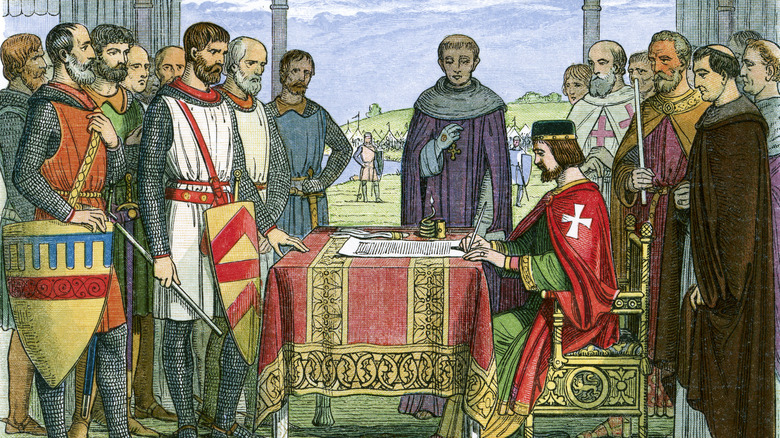Here's Why Anonymous People Are Called Jane Or John Doe
So we all know the detective scene, right? Detectives A and B — jaded veteran meets doe-eyed novice, perhaps — are in the morgue with a coroner. The coroner pulls a body out of one those refrigerated wall shelves, saying, "Found him this morning. No prints. No dental records. No ID. No clothes. And — get this — no face. Looks like bite marks here, here, and ... here." And what's the name of this anonymous and faceless fella? That's right: John Doe. And if it's a lady, Jane Doe.
Questions like, "Why John Doe?" and, "Why not Mark Smith?" aren't new. We all know that "John Doe" is used instead of real person's name as a placeholder if a person is found dead and unidentified, as our little detective scene above illustrates. But is John Doe ever used for the living? Why yes. The FBI hunts for numerous potential criminals, identifying the unknown as John Doe. As Cornell Law School explains, John Does can be unidentified hospitalized individuals. The John Doe moniker can also be used to protect people during trials if they fear reprisal or violence from certain parties.
As for why "John Doe," Language Humanities speculates that it's a just bog-standard English language male name. While this is true, it's not the whole story. The New York Times explains that the roots of John Doe go back to the Magna Carta in 1215 C.E., which necessitated the involvement of two nonspecific individuals to conduct certain legal actions.
800 years of anonymity
The Magna Carta is a fundamental document underpinning modern judiciary, especially civil rights issues. The British Library describes how passages of the Magna Carta reverberate onward in newer documents like the 1791 United States Bill of Rights, particularly the 39th clause guaranteeing all "free men" a fair and just trial. Part of that fairness required gathering a minimum of two "law-worthy and discreet men" to help in disputes related to property damage, as the Magna Carta itself says via the U.S. National Archives.
The passage in question describes inheritance from a landowner to an heir. In a nutshell, if someone comes into stewardship or guardianship of an heir's land and ruins it, that person has to pay damages, and the land goes to two other people. If those people do the same, then they suffer the same punishment. If a guardian "should commit destruction or waste, we will take recompense from him and the land will be assigned to two law-worthy and discreet men of that fee who will answer to us or to the person to whom we assign such land for the land's issues."
The Magna Carta doesn't use the name "John Doe" specifically, but as The New York Times describes, the legalistic precedent it established carried onward over the following hundreds of years, particularly in property-based court cases pitting landlords against tenants. Plaintiffs in those cases — tenants — were dubbed "John Doe" to protect them from their landlords, who were interestingly dubbed "Richard Roe."
Ashok Kumar, Jan Jansen, and Yamada Taro
My Law Questions says that John Doe was in such regular use in court cases by the 1600s that the 1659 Oxford English Dictionary defines "John Doe" specifically according to this purpose. Jane Doe came later in 1703. In both cases, they were used as hypothetical placeholder peoples and to conceal actual people. As for why "Doe," we can look to its aforementioned partner "Roe." Both are names for deer, which would have been commonly hunted in medieval times, and often refer to females of different types of deer. Very recently, we should all recognize "Roe vs. Wade," which substituted "Jane Roe" for the actual plaintiff Norma McCorvey.
Maybe Doe and Roe just rhymed, maybe they were easy to remember, but John and Jane Doe stuck in the U.S. and Canada all the way to the present, while they fell out of use in England. Other anonymous names have existed throughout history, like John Q. Public, but to avoid confusion across multiple court cases John Doe remains the standard. Use of the name also eventually expanded to law enforcement labeling unknown dead people.
Other languages and countries have their own versions of John Doe, like India, which Advaya Legal says is Ashok Kumar. While the history of the name is obviously different, its use is identical. In Japan it's Yamada Taro, in France it's Jean Dupont, in the Netherlands it's Jan Jansen, in Italy it's Mario Rossi, and many more, per Trusted Translations.


